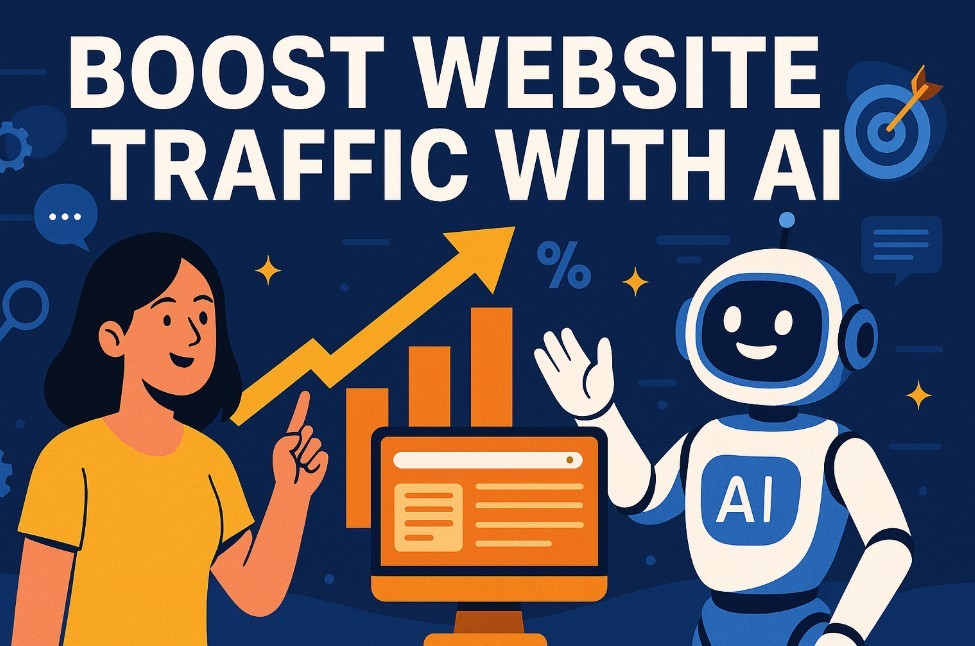Top 10 Best AI Writing Tools For Journalists, Editors in 2025
 |
| Top 10 Free and Paid AI Writing Tools For Journalists |
How AI Tools Boost Productivity for Journalists, Editors, and Reporters
AI tools empower journalists, editors, and reporters to work more efficiently by streamlining content creation through artificial intelligence, machine learning, deep learning, and natural language processing. These technologies assist with researching stories, identifying credible sources and data, and even supporting real-time collaboration to enhance productivity.
By accelerating the research and writing process, AI solutions help newsrooms scale their publishing efforts. While some tools can generate content automatically, human oversight remains essential for verifying facts and refining quality. Still, the time and resources saved are substantial.
Different media outlets have unique needs, so choosing the right AI tool is crucial. Fortunately, most of these tools are user-friendly—even for those without technical backgrounds—making them accessible to anyone in the journalism field.
READ MORE: Top 10 Biggest AI Trends To Dominate The World 2024
Benefits of AI in Journalism
AI tools are having a huge impact on journalism, transforming the way news companies create material and readers consume it. Here's how it enables journalists to produce more credible, interesting stories to their audiences:
Benefit No. 1: Personalization
AI can analyze users' interests, browsing history, and interaction patterns to give tailored news updates.
Readers can simply keep up with pertinent content without having to filter through extraneous items. This personalized approach improves the user experience, boosts engagement, and assists journalists in cultivating a devoted readership.
Benefit No. 2: Fact-checking
In the age of misinformation and "fake news," fact-checking has become vital in journalism. AI algorithms and data analysis allow journalists to:
Identify and isolate erroneous or misleading information.
Identify contradictions, prejudiced wording, and inaccuracies in the material.
Verify claims and obtain specific facts to preserve credibility and establish high reporting standards.
Benefit No. 3: Automated reporting
Journalists can provide structured data or insights, and AI algorithms can create content and human-like text without human intervention.
AI uses natural language processing to help:
Create articles that are timely, informative, and without bias.
Automate reporting to save time, minimize errors, and improve newsroom efficiency.
Streamline the news production process so journalists can concentrate on more investigative or analytical activities.
Top 10+ Free and Paid AI Writing Tools For Journalists
1. Murf
www.murf.ai
Price: $0-75
Have you considered the possibilities of audio articles for your news media company? Imagine if your audience could listen to hot news stories and articles rather than scrolling through countless lines of text.
This is where Murf's voice-over technology may assist journalists:
To create professional voiceovers for news stories, choose from a selection of 100% natural-sounding AI voices.
Create audio news stories for a larger global audience using a collection of 120+ AI voices in 20+ languages, including English, Spanish, and Portuguese.
Get studio-quality voiceovers for a fraction of the cost.
2. BeyondWords
https://beyondwords.io/
Price: Free trial; Pro: $89 per month.
As more people choose to listen to content on the go, turning your writing to audio is a great idea. BeyondWords comes to the rescue, providing hundreds of diverse voices to emphasize headings, quotations, and more. The free edition allows you to convert 30,000 characters every month, which is usually enough for an individual user and to test the service for businesses.
3. Jasper
https://www.jasper.ai/
Pricing:
Plans are billed annually and cost the following. Note that charges will vary depending on how many words you write every month.
The Starter plan costs around $40 per month for 35,000 words.
• Boss Mode: about. $82 a month for 100,000 words.
• Contact Jasper reps for price details.
Jasper AI (previously Jarvis) is a robust and flexible AI Content Generator that can help you streamline your workflows. Jasper allows you to create social network material, advertising text, emails, and SEO-optimized articles up to ten times faster. Furthermore, it allows you to write and read information in up to 25 languages, including English, Japanese, and Spanish.
Jasper is packed with features to help journalists write more efficiently. Some of the standout picks are imaginative Story, which helps you write imaginative stories. material Improver is a function that improves your material to make it more engaging, and Engaging Questions allows you to pose clever questions to your audience to increase interaction.
READ MORE: AI-Generated 'Fake' Photos Cause a Stir Worldwide And How to Detect
4. Quillbot
www.quillbot.com
Pricing
• Free and restricted to 125 words.
• Premium: $19.95 monthly, $13.33 semi-annually, and $8.33 per month annually.
QuillBot is an AI paraphrase tool that allows journalists to rephrase any text while maintaining the proper terminology, tone, and style. It also includes a grammar and plagiarism checker, as well as a summarizer.
The AI writing tool is adjustable, so you can choose how much of your vocabulary you wish to update. An AI-powered thesaurus provides you with a list of synonyms as well.
4. Writesonic
https://writesonic.com/
Price: $0-500+
Writesonic is an automatic text generator. The program claims it won't let you "run out of ideas" when it comes to writing advertising, landing pages, product descriptions, or whole blog entries. So, the next time you have writer's block, give it a try. The free trial allows you to write 6,250 words every month.
5. Vetted
https://vetted.ai/
Price: free
Vetted is regarded as an expert platform that offers a huge number of AI tools to journalists, allowing them to find certified news sources and write articles based on them. It also has experts from all over the world who can help journalists.
6. Article forge
https://www.articleforge.com/
Price:
• The monthly package costs $27.
• Yearly package costs $13 per month.
Article Forge is an AI platform-based studio that provides journalists with AI tools to help them generate long-form material more easily and quickly. It allows us to generate articles on a variety of themes such as industries, businesses, and entertainment simply by entering the word limit and keywords.
7. JECT.AI
https://ject.ai/
Price: free
JECT.AI is an AI platform that employs AI tools to assist journalists in identifying new trends and topics, discovering information, and conducting research to generate news. It helps to connect with other people who can assist us with our material.
8. Descript
https://www.descript.com/
Price:
• Monthly fee: $15 for creators.
• Pro subscription costs $30 per month.
Descript is an all-in-one AI tool for journalists, allowing them to create audio, videos, and material. It removes breathings and words like 'umm' and 'you know' while editing with filters.
9. Narrativa
https://www.narrativa.com/
Price: free
Narrativa is a AI tool for journalists that works with natural language generation to generate content and articles on various topics that are asked by its users to create content on. If not satisfied with the results, users can add their own text to refine it according to them.
10. Pinpoint
Price: free
https://www.pinpointai.com
Pinpoint is part of Google's Journalist Studio, a collection of tools that includes a fact-checking explorer, data visualizer, and real-time content analytics to help journalists operate more efficiently and safely.
Pinpoint uses Google Search, artificial intelligence, and machine learning to assist journalists in writing and researching content for breaking news, investigative stories, and other topics. It allows you to upload and analyze a large number of documents, up to 200,000 copies of various file kinds and sizes per collection, extracting key entities. It also allows you to share papers and work together with other journalists. The Hearst Media Group, The Boston Globe, and Verificado have all employed pinpoint.
Risks of AI Content Tools in Journalism: Job Loss, Bias & Creativity Concerns
As AI writing tools become more common in newsrooms, several challenges are emerging that could reshape the future of journalism.
1. Job Loss Among Journalists
AI tools can generate news articles, summaries, and reports faster and more efficiently than humans, raising concerns about unemployment—especially in entry-level positions. This shift may also reduce newsroom diversity and eliminate the cultural insight that human journalists bring.
2. Algorithmic and Human Bias
Bias in journalism—whether personal or algorithmic—can distort news coverage. AI tools risk amplifying existing biases in training data, leading to skewed narratives. Journalists must stay vigilant by fact-checking, using diverse sources, and maintaining transparency in reporting.
3. Lack of Creativity
AI excels at data-driven writing but struggles with creativity, nuance, and emotional depth. Over-reliance on AI may reduce reader engagement and article quality. To maintain balance, many outlets use AI for drafts while allowing journalists to add a human touch.
The Future of Journalism with AI
AI content tools offer speed and efficiency but can't replace human judgment, creativity, or ethical responsibility. The future of journalism will depend on finding a balance—leveraging AI for support while preserving the core values of accurate, thoughtful reporting.
The rise of AI content toolsOver the past few years, AI content tools have risen in popularity across various industries, journalism being no exception. Here's a closer look at the rise of AI content tools in journalism: • AI content tools such as automated article writers, chatbots, and summarization tools are being increasingly utilized by journalists to create news content. • These tools use natural language processing, machine learning, and similar technologies to analyze data and produce written content as per the requirement. • AI content tools not only save time by generating news articles in a few seconds, but also improve accuracy, scalability, and efficiency. • They can analyze large volumes of data in seconds, accurately summarize complex information, and even translate articles into different languages. • With the advancement of AI technologies, these tools are becoming more sophisticated and are already capable of writing articles that mimic human-written content. • Some news organizations have already implemented AI content tools in their workflow to produce news content faster and more efficiently. |
Why AI Tools Enhance—Not Replace—Journalists and Writers
AI writing tools are powerful and efficient, but they cannot replace the expertise, creativity, and critical thinking of skilled journalists and content creators. Instead, these tools should be seen as productivity boosters—augmenting your writing process with advanced technology to help you produce content faster and more effectively.
Beyond content generation, AI tools offer a wide range of applications. They can analyze large data sets, create clear visualizations, improve video and audio content, generate headline ideas, repurpose existing articles, and uncover unique story angles. When used wisely, AI tools can streamline your workflow while preserving the human touch essential to impactful journalism.
 Top 10 Best Apps/Websites to Find An AI - Virtual Girlfriend Top 10 Best Apps/Websites to Find An AI - Virtual Girlfriend AI girlfriends can share everything with you in life. Check out Top 10 Best AI Girlfriend Apps/Websites. |
 Who is the Father of Artificial Intelligence: History and Timeline of AI Who is the Father of Artificial Intelligence: History and Timeline of AI Artificial intelligence is the most recent technological breakthrough, with far-reaching implications for all professions and aspects of social life. So, who is the father of ... |
 Top 14 Free AI Tools to Create Videos from Text Top 14 Free AI Tools to Create Videos from Text Thanks to the development of artificial intelligence (AI) platforms, users can now create images, Rtexts, videos, and sounds with free tools. |



























